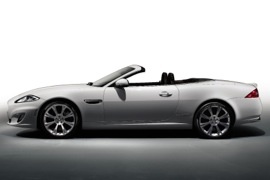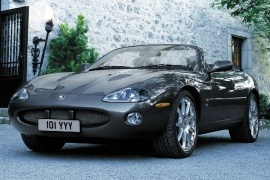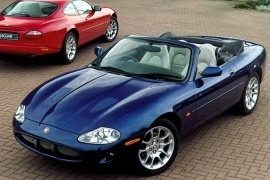
JAGUAR XKR Convertible
Generations Timeline, Specs and Pictures

The revised XKR released in 2009 was a strong rival for the Porsche 911/ BMW 6/ Mercedes SL.
The XKR runs on the Jaguar’s most performant 5.0-liter V8 503hp engine at that time, which rockets the car from 0 to 60 mph in only 4.8 seconds . The engine is paired with a 6-speed automatic transmission.
The most important addition for this car is the new adaptive suspension system and which allows tight body control and a fast reaction in turns.
The interior was a luxurious one, everything being covered in quality hides and woods.
The electric roof was made of three layers of Thinsulate material and had a variety of colors to be chosen from: beige, grey, burgundy and green. It took only 18 seconds to stow the roof.
The car’s practicality is a bit reduced, as the rear seats are very small and probably right for children only. The load area had 313 liters, which is enough for a few bags, but definitely not for a long vacation.
The XKR Convertible had lots of safety features: many airbags, traction and stability control and a pop-up pedestrian-protecting bonnet. As an optional features, Jaguar offered a cruise control system, able to slow down the vehicle in case another car merged into its path.

Designed to change the character of the XKR without completely throwing it away, the XKR-S came with an explosive performance given by the updated engine.
More expensive than the standard XKR, the XKR-s featured a redesigned exterior look with a new front fascia, bigger wheel and a spoiler at the back - all to increase stability at high speeds. And the XKR could go up to 300 km/h.
The most important changes were to be found underneath, as Jaguar improved the XKR in almost every aspect: the front suspension was stiffened, resulting in a better steering and handling precision. The electronic differential software and the damper control software were updates, as well as the steering system software.
While the XKR-S featured all of qualities of the regular XKR, it offered an extra level of precision, more power and more torque. The upgraded 5.0-liter supercharged engine produced 550 hp and 502 lb.-ft of torque.
The exhaust system was refreshed to provide a more exciting sound.
Inside, the XKR-s came with specific carbon-leather trimmed versions of the Jaguar’s Performance seats. The heated seats were fitted with integrated head rests and racing harness cut-outs. The 16-way adjustable seats had carbon leather inserts with contrast micro piping. Soft touch classy materials were used throughout the cabin, giving a feeling of exclusivity.

Jaguar introduced the second generation of the XKR at the 2005 Frankfurt Motor Show, and in the following year, it unveiled the open-top version for it.
The British brand had a long history of convertible vehicles, and it kept offering them on the market, with a different styling approach than Ferrari or Mercedes-Benz. They were built for long journeys, with powerful engines under the hood and a special charisma on their look.
Ian Callum designed the second generation of the XK/XKR when he was in charge of the Jaguar’s design department. He was inspired by the 1961 E-Type model, which was seen on the car’s oval grille. The lower part of the bumper featured a different mesh-grille than the rest of the XK range. On the hood, the extracting vents helped to cool the engine. Jaguar XKR convertible needed only 18 seconds to open or close the soft-top.
Despite the long wheelbase, the XKR was a 2+2 vehicle, but with very limited room in the back since the canvas-top was stored between the bench and the trunk. At the front, a pair of bolstered seats were part of the game and offered good side support and enough comfort on long journeys. A wind-stopper could have been placed over the rear seats to prevent wind turbulences for the front passengers.
The XKR Convertible was powered by a newly developed 4.2-liter V8 supercharged engine. It sent the 420 hp to the rear wheels via a 6-speed automatic gearbox.

Jaguar decided to introduce a facelift for its XK8 GT range, and, along with the rest of the stable, the convertible and the KXR Convertible went through important updates.
Six years after the introduction, the XKR started to lack the performance to keep up with the market competition. It had to evolve, and the evolution came with more power and updated features.
Sleek and powerful, the XKR Convertible was the fastest quickest production cabriolet of the family. At the front, the apron-mounted oval grille resembled old Jaguar models, and the cat-badge was installed on the upper side of the bumper. On the hood, a pair of slats used to cool the engine made the most striking aesthetic difference between the XKR and its less-powered brothers, the XK8. It didn’t look just like a regular open-top GranTurismo.
Inside, instead of the three-dials on the center stack, there was a newly installed display. It was the beginning of a new era, where digitization started to replace the analog style. The J-pattern for the gear-selector remained the same, with a chromed rim and wood trim around it. Even if there was not enough room for someone in the back, the rear seats were covered in the same leather and with the same attention to details as the front ones.
The 2003 Jaguar XKR Convertible lost the old 4.0-liter V8 and gained a 4.2-liter unit that offered almost 40 ponies more. Thanks to a 6-speed automatic transmission that sent power to the rear wheels, the car rocketed to 100 kph (62 mph) from standing still in 5.6 seconds.

If you want to design a real British sports car, you need a British designer.
That’s what Jaguar said when it employed Ian Callum to draw the new XK series lines. And they weren’t wrong.
Pininfarina, Bertone, or Giugiaro indeed designed for various brands, from the U.S. to the European and Korean brands. Pininfarina designed several Aston Martins. Giugiaro made a stunning concept for Jaguar (the Kensington). But the most beautiful British sports car, the E-Type, was designed by Malcolm Sayer, born and raised in the U.K. Ian Callum took its inspiration from the E-Type, and the result was a great looking vehicle. As for the R-version, that was the spiced-up version of the XK8.
The long hood (or bonnet to keep up with the Brits) featured two vents, which helped cool the engine. It is impossible for a Jaguar fan not to notice the oval-shaped grille, which resembled the one installed on the E-Type. Just like its famous ancestor, the XK featured a front-hinged hood, unlike most of the other cars on the market, which was fitted with rear-hinged ones. The soft-top version featured a power-roof, which was folded down behind the rear seats.
Inside, apart from some Ford Fiesta buttons, Jaguar installed mostly premium materials, from the Connely leather to the wood-trims on the dash. Other than that, the XKR cabin was a luxurious and cozy place to be, at least on the front seats. The rear seats offered enough room for a small dog and an umbrella.
Under the hood, Jaguar installed its latest V8 supercharged engine. It was paired as standard to a 5-speed automatic, and it proved to be the quickest production vehicle made by the famous British brand.























































